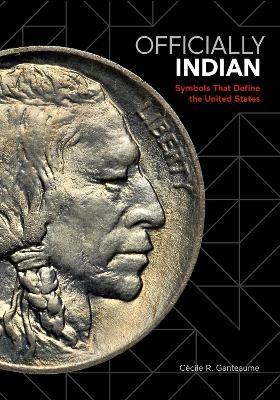
Officially Indian
Symbols that Define the United States
Seiten
2017
University of Minnesota Press (Verlag)
978-1-5179-0330-5 (ISBN)
University of Minnesota Press (Verlag)
978-1-5179-0330-5 (ISBN)
From maps, monuments, and architectural features to stamps and currency, images of Native Americans have been used again and again on visual expressions of American national identity since before the country’s founding. In the first in-depth study of this extraordinary archive, Cécile R. Ganteaume argues that these representations are not empty symbols but reflect how official and semi-official government institutions—from the U.S. Army and the Department of the Treasury to the patriotic fraternal society Sons of Liberty—have attempted to define what the country stands for. Seen collectively and studied in detail, American Indian imagery on a wide range of emblems—almost invariably distorted and bearing little relation to the reality of Native American–U.S. government relations—sheds light on the United States’ evolving sense of itself as a democratic nation.
Generation after generation, Americans have needed to define anew their relationship with American Indians, whose lands they usurped and whom they long regarded as fundamentally different from themselves. Such images as a Plains Indian buffalo hunter on the 1898 four-cent stamp and Sequoyah’s likeness etched into glass doors at the Library of Congress in 2013 reveal how deeply rooted American Indians are in U.S. national identity. While the meanings embedded in these artifacts can be paradoxical, counterintuitive, and contradictory to their eras’ prevailing attitudes toward actual American Indians, Ganteaume shows how the imagery has been crucial to the ongoing national debate over what it means to be an American.
Officially Indian is published in concert with the Americans exhibition, which opens October 26, 2017, at the National Museum of the American Indian in Washington, D.C. American Indians represent less than 1 percent of the U.S. population, yet names and images of Indians are everywhere: military weapons, songs, town names, advertising, and that holiday in November. Americans invites visitors to take a closer look, and to ask why. Featuring nearly 350 objects and images, from a Tomahawk missile to baking powder cans, Americans examines the staying power of four stories (Thanksgiving, Pocahontas, the Trail of Tears, and the Battle of Little Bighorn) that are woven into the fabric of both American history and contemporary life. By highlighting what has been remembered, contested, cherished, and denied about these stories, and why they continue to resonate, this exhibition shows that Americans have always been fascinated, conflicted, and profoundly shaped by their relationship to American Indians.
Generation after generation, Americans have needed to define anew their relationship with American Indians, whose lands they usurped and whom they long regarded as fundamentally different from themselves. Such images as a Plains Indian buffalo hunter on the 1898 four-cent stamp and Sequoyah’s likeness etched into glass doors at the Library of Congress in 2013 reveal how deeply rooted American Indians are in U.S. national identity. While the meanings embedded in these artifacts can be paradoxical, counterintuitive, and contradictory to their eras’ prevailing attitudes toward actual American Indians, Ganteaume shows how the imagery has been crucial to the ongoing national debate over what it means to be an American.
Officially Indian is published in concert with the Americans exhibition, which opens October 26, 2017, at the National Museum of the American Indian in Washington, D.C. American Indians represent less than 1 percent of the U.S. population, yet names and images of Indians are everywhere: military weapons, songs, town names, advertising, and that holiday in November. Americans invites visitors to take a closer look, and to ask why. Featuring nearly 350 objects and images, from a Tomahawk missile to baking powder cans, Americans examines the staying power of four stories (Thanksgiving, Pocahontas, the Trail of Tears, and the Battle of Little Bighorn) that are woven into the fabric of both American history and contemporary life. By highlighting what has been remembered, contested, cherished, and denied about these stories, and why they continue to resonate, this exhibition shows that Americans have always been fascinated, conflicted, and profoundly shaped by their relationship to American Indians.
Cécile R. Ganteaume is associate curator at the Smithsonian National Museum of the American Indian.
| Erscheinungsdatum | 31.01.2018 |
|---|---|
| Nachwort | Paul Chaat Smith |
| Vorwort | Colin G. Calloway |
| Zusatzinfo | 50 color plates |
| Verlagsort | Minnesota |
| Sprache | englisch |
| Maße | 178 x 254 mm |
| Themenwelt | Geschichte ► Teilgebiete der Geschichte ► Kulturgeschichte |
| Sozialwissenschaften ► Ethnologie ► Volkskunde | |
| Sozialwissenschaften ► Soziologie | |
| ISBN-10 | 1-5179-0330-0 / 1517903300 |
| ISBN-13 | 978-1-5179-0330-5 / 9781517903305 |
| Zustand | Neuware |
| Haben Sie eine Frage zum Produkt? |
Mehr entdecken
aus dem Bereich
aus dem Bereich
der stille Abschied vom bäuerlichen Leben in Deutschland
Buch | Hardcover (2023)
C.H.Beck (Verlag)
23,00 €
vom Mittelalter bis zur Gegenwart
Buch | Softcover (2024)
C.H.Beck (Verlag)
12,00 €


